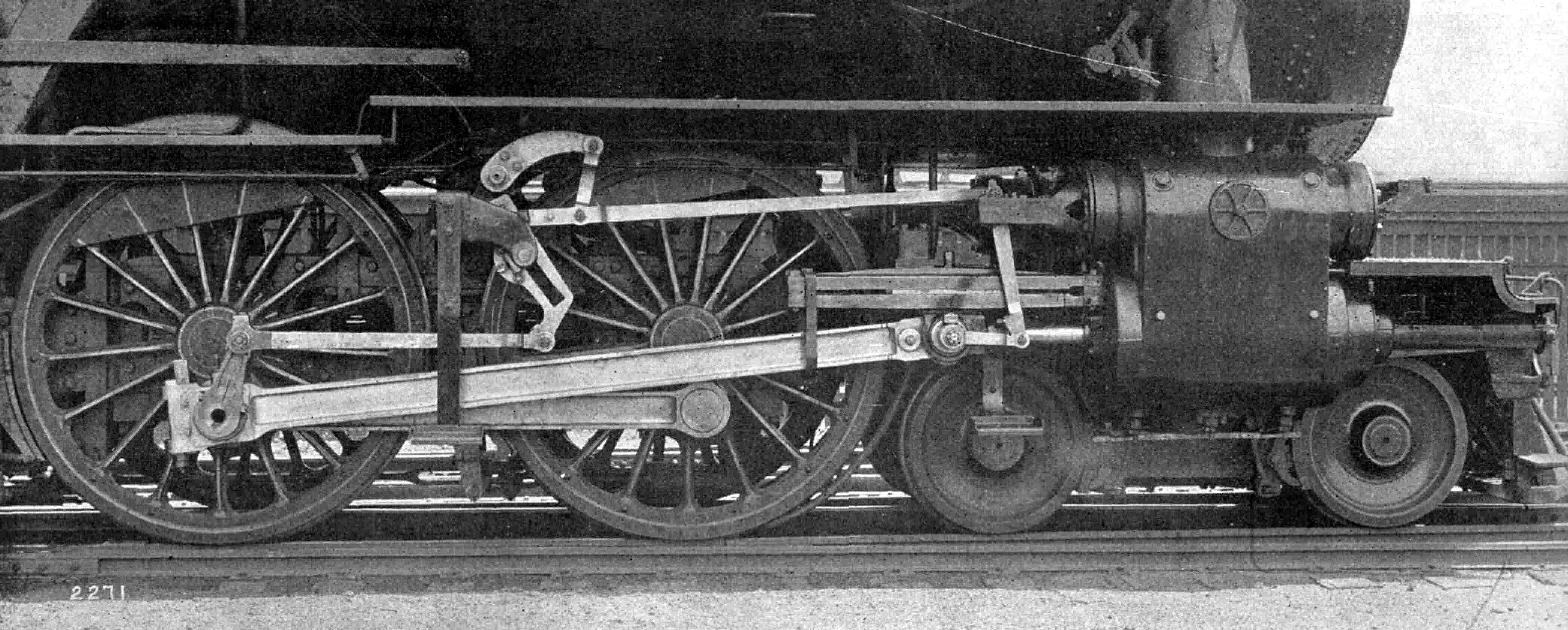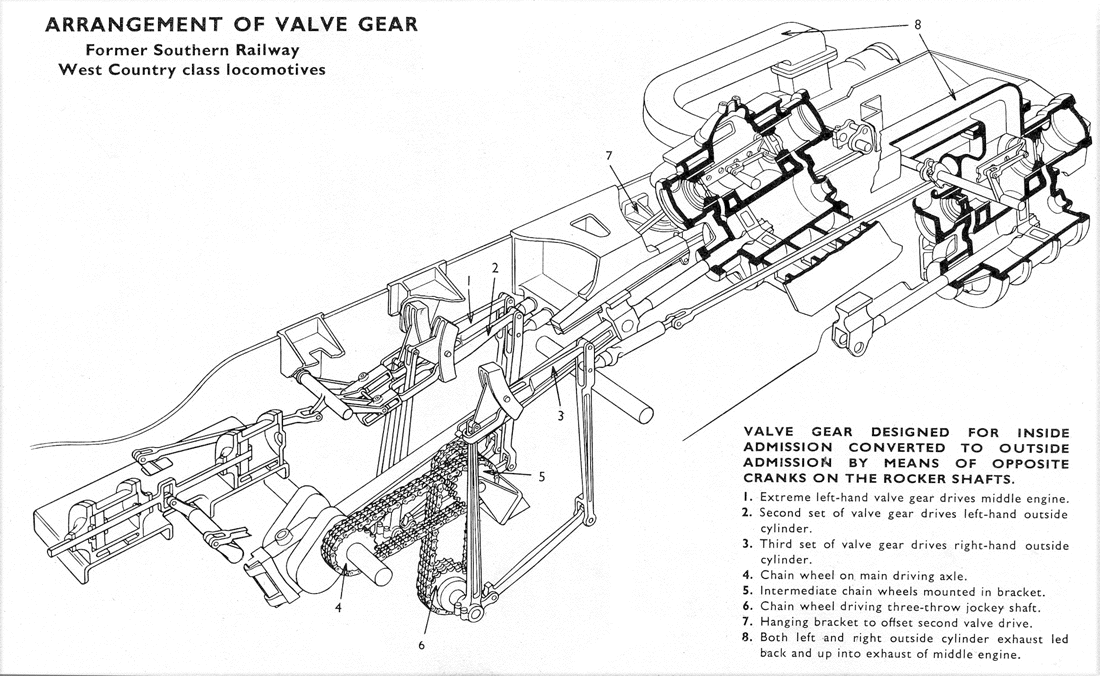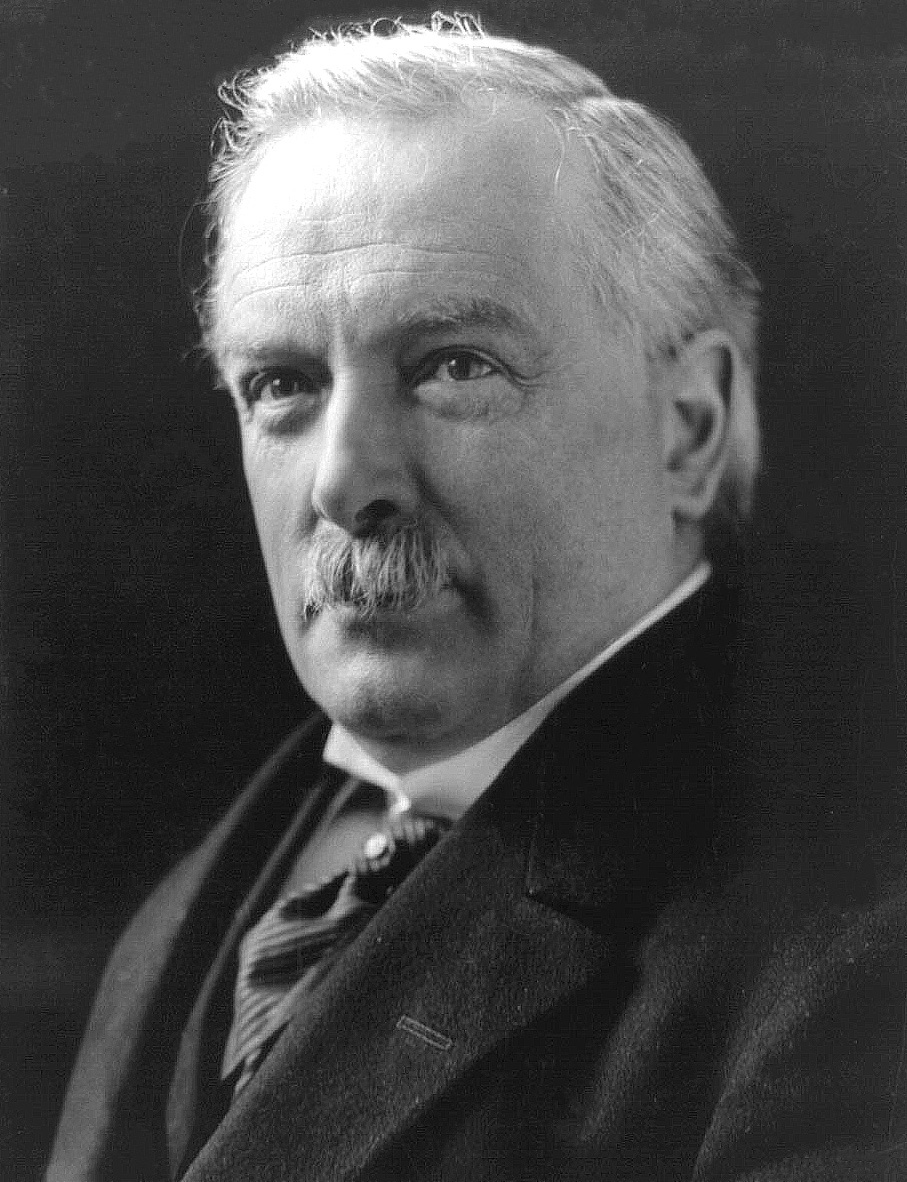|
SR Leader Class
The Leader was a class of experimental articulated steam locomotive, produced in the United Kingdom to the design of the innovative engineer Oliver Bulleid. The Leader was an attempt to extend the life of steam traction by eliminating many of the operational drawbacks associated with existing steam locomotives. It was intended as a replacement for the ageing fleet of M7 class tank engines still in operation on the Southern Railway (SR). Design work began in 1946 and development continued after the nationalisation of the railways in 1948, under the auspices of British Railways (BR). The Leader project was part of Bulleid's desire to modernise the steam locomotive based on experience gained with the Southern Railway's fleet of electric stock. Bulleid considered that attitudes towards the labour-intensity of steam operation had changed during the post-war period, favouring dieselisation and electrification. In an effort to demonstrate the continued potential of steam, Bulleid pu ... [...More Info...] [...Related Items...] OR: [Wikipedia] [Google] [Baidu] |
Oliver Bulleid
Oliver Vaughan Snell Bulleid Commander of the Order of the British Empire, CBE (19 September 1882 – 25 April 1970) was a British railway and mechanical engineer best known as the Chief Mechanical Engineer (CME) of the Southern Railway (UK), Southern Railway between 1937 and the 1948 nationalisation, developing many well-known locomotives. Early life and Great Northern Railway He was born in Invercargill, New Zealand, to William Bulleid and his wife Marian Pugh, both British immigrants. On the death of his father in 1889, his mother returned to Llanfyllin, Wales, where the family home had been, with Bulleid. In 1901, after a technical education at Accrington Grammar School, he joined the Great Northern Railway (Great Britain), Great Northern Railway (GNR) at Doncaster at the age of 18, as an apprentice under H. A. Ivatt, the Chief Mechanical Engineer (CME). After a four-year apprenticeship, he became the assistant to the Locomotive Running Superintendent, and a year lat ... [...More Info...] [...Related Items...] OR: [Wikipedia] [Google] [Baidu] |
Electric Locomotives
An electric locomotive is a locomotive powered by electricity from overhead lines, a third rail or on-board energy storage such as a battery or a supercapacitor. Locomotives with on-board fuelled prime movers, such as diesel engines or gas turbines, are classed as diesel-electric or gas turbine-electric and not as electric locomotives, because the electric generator/motor combination serves only as a power transmission system. Electric locomotives benefit from the high efficiency of electric motors, often above 90% (not including the inefficiency of generating the electricity). Additional efficiency can be gained from regenerative braking, which allows kinetic energy to be recovered during braking to put power back on the line. Newer electric locomotives use AC motor-inverter drive systems that provide for regenerative braking. Electric locomotives are quiet compared to diesel locomotives since there is no engine and exhaust noise and less mechanical noise. The lack of rec ... [...More Info...] [...Related Items...] OR: [Wikipedia] [Google] [Baidu] |
Valve Gear
The valve gear of a steam engine is the mechanism that operates the inlet and exhaust valves to admit steam into the cylinder and allow exhaust steam to escape, respectively, at the correct points in the cycle. It can also serve as a reversing gear. It is sometimes referred to as the "motion". Purpose In the simple case, this can be a relatively simple task as in the internal combustion engine in which the valves always open and close at the same points. This is not the ideal arrangement for a steam engine, though, because greatest power is achieved by keeping the inlet valve open throughout the power stroke (thus having full boiler pressure, minus transmission losses, against the piston throughout the stroke) while peak efficiency is achieved by only having the inlet valve open for a short time and then letting the steam expand in the cylinder (expansive working). The point at which steam stops being admitted to the cylinder is known as the '' cutoff'', and the optimal positio ... [...More Info...] [...Related Items...] OR: [Wikipedia] [Google] [Baidu] |
Bulleid Chain-driven Valve Gear
The Bulleid chain-driven valve gear is a type of steam locomotive valve gear designed by Oliver Bulleid during the Second World War for use on his Pacific (4-6-2) designs. It was peculiar to the Southern Railway in Britain, and borrowed from motor-vehicle practice in an attempt to create a compact and efficient design with a minimum of service requirements. Design principles Bulleid's decision to have three cylinders, all driving the middle coupled axle of his Merchant Navy and West Country / Battle of Britain classes, gave rise to several problems. As each cylinder was to have its own separate valve gear, this left very little space for the conventional inside set of motion. This prompted Bulleid to design a new miniaturised Walschaerts motion that was compact enough to enclose the whole system in a casing. All three sets of valve gear were worked from an auxiliary three-throw crankshaft. A Morse inverted-tooth drive chain ran horizontally from a triple sprocket on the ... [...More Info...] [...Related Items...] OR: [Wikipedia] [Google] [Baidu] |
Brighton Railway Works
Brighton railway works (also known as Brighton locomotive works, or just the Brighton works) was one of the earliest railway-owned locomotive repair works, founded in 1840 by the London and Brighton Railway in Brighton, England, and thus pre-dating the more famous railway works at Crewe, Doncaster and Swindon. The works grew steadily between 1841 and 1900 but efficient operation was always hampered by the restricted site, and there were several plans to close it and move the facility elsewhere. Nevertheless, between 1852 and 1957 more than 1200 steam locomotives as well as prototype diesel electric and electric locomotives were constructed there, before the eventual closure of the facility in 1962. After use as a factory for constructing bubble cars, the facility was demolished and has since been redeveloped as part of the New England Quarter of Brighton. London and Brighton Railway The earliest locomotive servicing facility at Brighton was a small engine shed to the north-west ... [...More Info...] [...Related Items...] OR: [Wikipedia] [Google] [Baidu] |
Meyer Locomotive
A Meyer locomotive is a type of articulated locomotive. The design was never as popular as the Garratt or Mallet locomotives. It can be best regarded as 19th Century competition for the early compound Mallet and also the Fairlie articulated designs. Most single cab modern trains are of a similar design such as power cars, freight diesel locomotives, and some passenger locomotives. Development and design The Meyer was in fact invented by Austrian engineer Wenzel Günther of the Wiener Neustädter Lokomotivfabrik for the Semmering Trials of 1851. However, the technology wasn't yet developed for the steam to be reliably transported to the bogies with reasonable amount of leaks, and despite generally good performance of the design on the trials the company abandoned the idea. It was reinvigorated by Frenchman Jean-Jacques Meyer (1804-1877), who took out a patent on the design in 1861. The first locomotive, an named ''L'Avenir'' (Future), was built by in 1868 with the support of a ... [...More Info...] [...Related Items...] OR: [Wikipedia] [Google] [Baidu] |
Fairlie Locomotive
A Fairlie is a type of articulated locomotive, articulated steam locomotive that has the driving wheels on bogies. The locomotive may be double-ended (a double Fairlie) or single ended (a single Fairlie). Fairlies are most famously associated with the Ffestiniog Railway in North Wales. While the Fairlie locomotives are now used only on heritage railways, the vast majority of diesel locomotive, diesel and electric locomotives in the world today follow a form not very different from the Fairlie — two power trucks with all axles driven, and many also follow the Fairlie's double-ended concept, capable of being driven equally well in both directions. Development of the design The Scottish people, Scottish engineer Robert Francis Fairlie patented his design in 1864. He had become convinced that the conventional pattern of locomotive was seriously deficient; they wasted weight on unpowered wheels (the maximum tractive effort a locomotive can exert is a function of the weight ... [...More Info...] [...Related Items...] OR: [Wikipedia] [Google] [Baidu] |
Garratt
A Garratt (often referred to as a Beyer Garratt) is a type of steam locomotive invented by British engineer Herbert William Garratt that is articulated into three parts. Its boiler, firebox, and cab are mounted on a centre frame or "bridge". The two other parts, one at each end, have a pivot to support the central frame; they consist of a steam engine unit – with driving wheels, trailing wheels, valve gear, and cylinders, and above it, fuel and/or water storage. Articulation permits locomotives to negotiate curves that might restrict large rigid-framed locomotives. The design also provides more driving wheels per unit of locomotive weight, permitting operation on lightly engineered track. Garratt locomotives produced as much as twice the power output of the largest conventional locomotives of railways that introduced them, reducing the need for multiple locomotives and crews. Advantages of the Garratt concept The principal benefit of the Garratt design is that the boil ... [...More Info...] [...Related Items...] OR: [Wikipedia] [Google] [Baidu] |
Sleeve Valve
The sleeve valve is a type of valve mechanism for piston engines, distinct from the usual poppet valve. Sleeve valve engines saw use in a number of pre-World War II luxury cars and in the United States in the Willys-Knight car and light truck. They subsequently fell from use due to advances in poppet-valve technology, including sodium cooling, and the Knight system double sleeve engine's tendency to burn a lot of lubricating oil or to seize due to lack of it. The Scottish Argyll company used its own, much simpler and more efficient, single sleeve system (Burt-McCollum) in its cars, a system which, after extensive development, saw substantial use in British aircraft engines of the 1940s, such as the Napier Sabre, Bristol Hercules, Centaurus, and the promising but never mass-produced Rolls-Royce Crecy, only to be supplanted by the jet engines. Description A sleeve valve takes the form of one or more machined sleeves. It fits between the piston and the cylinder wall in the cylin ... [...More Info...] [...Related Items...] OR: [Wikipedia] [Google] [Baidu] |
0-6-0
Under the Whyte notation for the classification of steam locomotives, represents the wheel arrangement of no leading wheels, six powered and coupled driving wheels on three axles and no trailing wheels. This was the most common wheel arrangement used on both tender and tank locomotives in versions with both inside and outside cylinders. In the United Kingdom, the Whyte notation of wheel arrangement was also often used for the classification of electric and diesel-electric locomotives with side-rod coupled driving wheels. Under the UIC classification, popular in Europe, this wheel arrangement is written as C if the wheels are coupled with rods or gears, or Co if they are independently driven, the latter usually being electric and diesel-electric locomotives. Overview History The 0-6-0 configuration was the most widely used wheel arrangement for both tender and tank steam locomotives. The type was also widely used for diesel switchers (shunters). Because they lack leading a ... [...More Info...] [...Related Items...] OR: [Wikipedia] [Google] [Baidu] |
Turntable (railroad)
In rail terminology, a railway turntable or wheelhouse is a device for turning railway rolling stock, usually locomotives, so that they can be moved back in the direction from which they came. Naturally, it is especially used in areas where economic considerations or a lack of sufficient space have served to weigh against the construction of a turnaround wye. In the case of steam locomotives, railways needed a way to turn the locomotives around for return trips as their controls were often not configured for extended periods of running in reverse and in many locomotives the top speed was lower in reverse motion. In the case of diesel locomotives, though most can be operated in either direction, they are treated as having "front ends" and "rear ends" (often determined by reference to the location of the crew cab). When operated as a single unit, the railway company often prefers, or requires, that a diesel locomotive is run "front end" first. When operated as part of a multiple ... [...More Info...] [...Related Items...] OR: [Wikipedia] [Google] [Baidu] |
Tender (rail)
A tender or coal-car (US only) is a special rail vehicle hauled by a steam locomotive containing its fuel (wood, coal, oil or torrefied biomass) and water. Steam locomotives consume large quantities of water compared to the quantity of fuel, so their tenders are necessary to keep them running over long distances. A locomotive that pulls a tender is called a tender locomotive. Locomotives that do not have tenders and carry all their fuel and water on board the locomotive itself are called tank locomotives. A corridor tender is a locomotive tender with a passageway to one side, allowing crew changes on the fly. A brake tender is a tender that is heavy and used (primarily) to provide greater braking efficiency. General functions The largest steam locomotives are semi-permanently coupled by a drawbar to a tender that carries the water and fuel. The fuel source used depends on what is economically available locally. In the UK and parts of Europe, a plentiful supply of coal made ... [...More Info...] [...Related Items...] OR: [Wikipedia] [Google] [Baidu] |








.jpg)

